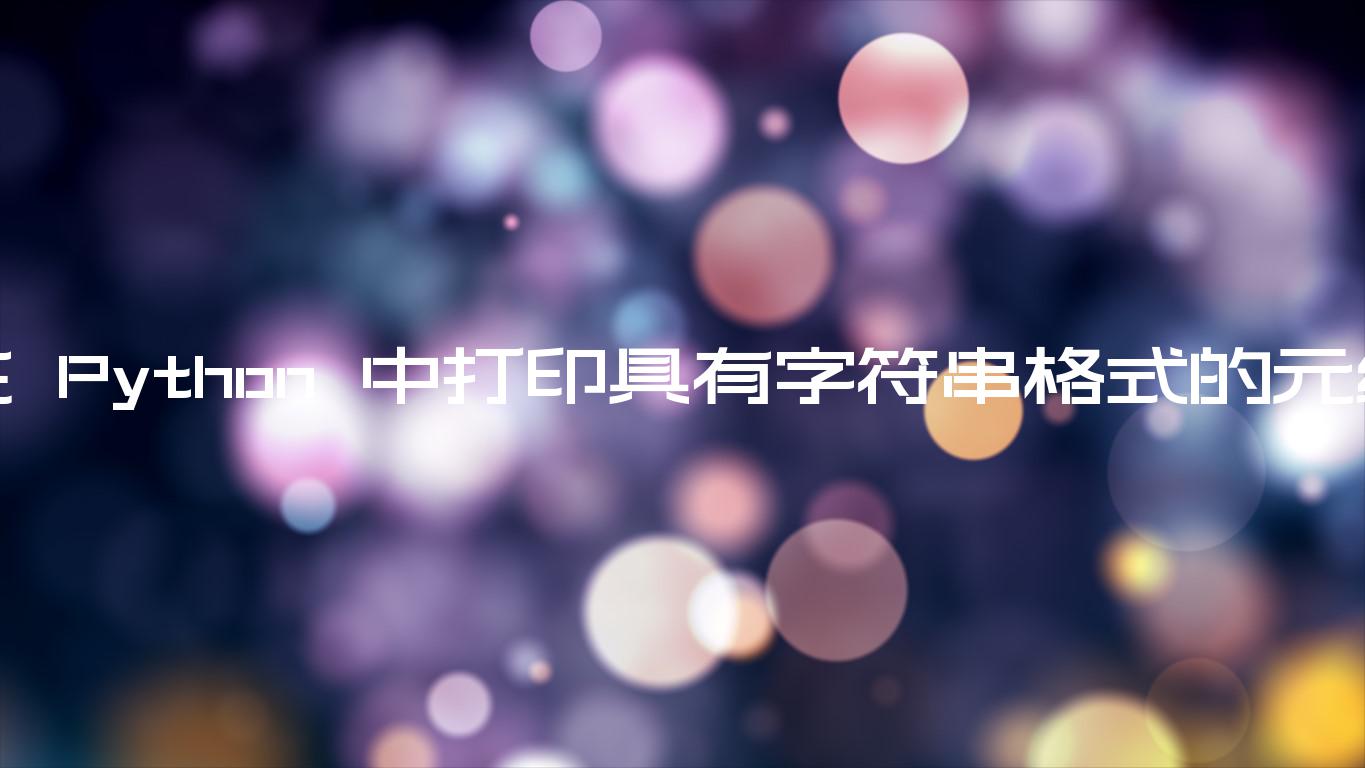在 Python 中打印带有字符串格式的元组
Print a tuple with string formatting in Python
使用格式化的字符串文字来打印具有字符串格式的元组,例如
print(f'Example tuple: {my_tuple}'). 格式化的字符串文字让我们通过在字符串前加上前缀来在字符串中包含表达式和变量f。
主程序
my_tuple = ('a', 'b', 'c') # ✅ format a string with a tuple result = f'Example tuple: {my_tuple}' print(result) # 👉️ Example tuple: ('a', 'b', 'c') # ✅ access specific elements in the tuple result = f'first: {my_tuple[0]}, second: {my_tuple[1]}, third: {my_tuple[2]}' print(result) # 👉️ first: a, second: b, third: c # ---------------------------------------- # ✅ using the str.format() method result = 'first: {}, second: {}, third: {}'.format(*my_tuple) print(result) # 👉️ first: a, second: b, third: c # ---------------------------------------- # ✅ print a tuple without the parentheses result = ','.join(my_tuple) print(result) # 👉️ 'a,b,c'
第一个示例使用格式化字符串文字来打印具有字符串格式的元组。
主程序
my_tuple = ('a', 'b', 'c') result = f'Example tuple: {my_tuple}' print(result) # 👉️ Example tuple: ('a', 'b', 'c')
格式化字符串文字 (f-strings) 让我们通过在字符串前加上f.
主程序
my_str = 'is subscribed:' my_bool = True result = f'{my_str} {my_bool}' print(result) # 👉️ is subscribed: True
确保将表达式括在大括号 –{expression}中。
您可以使用方括号表示法访问索引处的元组元素。
主程序
my_tuple = ('a', 'b', 'c') result = f'first: {my_tuple[0]}, second: {my_tuple[1]}, third: {my_tuple[2]}' print(result) # 👉️ first: a, second: b, third: c
Python 索引是从零开始的,因此元组中的第一个元素的索引为,最后一个元素的索引为or 。
0-1 len(my_tuple) - 1或者,您可以使用该str.format()方法。
主程序
my_tuple = ('a', 'b', 'c') result = 'Example tuple: {}'.format(my_tuple) print(result) # 👉️ Example tuple: ('a', 'b', 'c') result = 'first: {}, second: {}, third: {}'.format(*my_tuple) print(result) # 👉️ first: a, second: b, third: c
str.format方法
执行字符串格式化操作。
调用该方法的字符串可以包含使用花括号指定的替换字段{}。
确保为该
format() 方法提供的参数与字符串中的替换字段一样多。format()如果您需要在字符串中访问元组元素,则可以使用可迭代解包运算符在对方法的调用中解包元组元素。
主程序
my_tuple = ('a', 'b', 'c') result = 'first: {}, second: {}, third: {}'.format(*my_tuple) print(result) # 👉️ first: a, second: b, third: c
*可迭代解包运算符
使我们能够在函数调用、推导式和生成器表达式中解包可迭代对象。
可迭代解包运算符解包元组并将其元素作为多个逗号分隔的参数传递给方法调用。
str.format()如果您需要打印不带括号的元组,请使用该str.join()
方法。
主程序
my_tuple = ('a', 'b', 'c') result = ','.join(my_tuple) print(result) # 👉️ 'a,b,c'
str.join方法将一个可迭代对象作为参数并返回一个字符串,该字符串是可迭代对象中字符串的串联。
请注意,
TypeError如果可迭代对象中有任何非字符串值,该方法将引发 a。如果您的元组包含数字或其他类型,请在调用之前将所有值转换为字符串join()。
主程序
tuple_of_int = (1, 2, 3) result = ','.join(str(item) for item in tuple_of_int) print(result) # 👉️ '1,2,3'
该示例使用生成器表达式将元组中的每个整数转换为字符串。
生成器表达式用于对每个元素执行某些操作或选择满足条件的元素子集。
调用该join()方法的字符串用作元素之间的分隔符。
我们在示例中使用了逗号,但您可以使用任何其他分隔符,例如空字符串来连接没有分隔符的元组元素。
